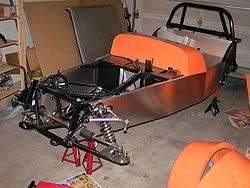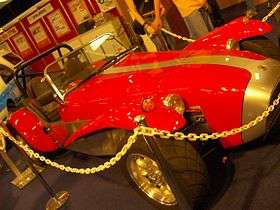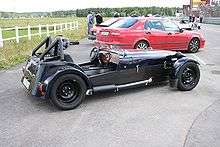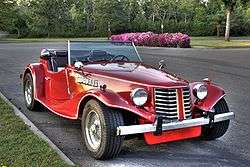Kit car



A kit car, also known as a component car, is an automobile that is available as a set of parts that a manufacturer sells and the buyer himself then assembles into a functioning car. Usually, many of the major mechanical systems such as the engine and transmission are sourced from donor vehicles or purchased new from other vendors. Kits vary in completeness, consisting of as little as a book of plans, or as much as a complete set with all components included.
There is a sub-set of the kit car, commonly referred to as a "re-body", in which a commercially manufactured vehicle has a new (often fiberglass) body put on the running chassis. Most times, the existing drive gear and interior are retained. These kits require less technical knowledge from the builder, and because the chassis and mechanical systems were designed, built, and tested by a major automotive manufacturer, a re-body can lead to a much higher degree of safety and reliability.
The definition of a kit car usually indicates that a manufacturer constructs multiple kits of the same vehicle, each of which it then sells to a third party to build. A kit car should not be confused with a 'hand built' car or 'special' car, which is typically built from scratch by an individual.
History

Kit cars have been around from the earliest days of the automobile. In 1896 the Englishman Thomas Hyler-White developed a design for a car that could be assembled at home and technical designs were published in a magazine called The English Mechanic.[1] In the USA, the Lad's Car of 1912 could be bought for $160 ($3000 US in 2006) fully assembled or $140 ($2600 US in 2006) in kit form.[2]
It was not until the 1950s that the idea really took off. Car production had increased considerably and with rust proofing in its infancy many older vehicles were being sent to breaker yards as their bodywork was beyond economic repair. An industry grew up supplying new bodies and chassis to take the components from these cars and convert them into new vehicles, particularly into sports cars. Fiber reinforced plastic (aka "GRP," or "fiberglass") was coming into general use and made limited-scale production of automobile body components much more economical.[3] Also, in the UK up to the mid-1970s, kit cars were sometimes normal production vehicles that were partially assembled as this avoided the imposition of purchase tax as the kits were assessed as components and not vehicles. The Lotus Elan, for example, was available in this form. It was often claimed that the kits could be taken home and completed in only a weekend.
During the 1970s many kits had bodies styled as sports cars that were designed to bolt directly to VW Beetle chassis. This was popular as the old body could be easily separated from the chassis leaving virtually all mechanical components attached to the chassis and a GRP-body from the kit supplier shop fitted. This made the Beetle one of the most popular "donor" vehicles of all time.[4] Examples of this conversion include the Bradley GT, Sterling, and Sebring which were made by the thousands and many are still around today. Volkswagen based dune buggies also appeared in relatively large numbers in the 1960s and 1970s based usually on a shortened floor pan.
Current kit cars are frequently replicas of well-known and often expensive classics and are designed so that anyone with a measure of technical skill can build them at home to a standard where they can be driven on the public roads. These replicas are in general appearance like the original, but their bodies are often made of fiberglass mats soaked in polyester resin instead of the original sheet metal. The AC Cobra and the Lotus 7 are particularly popular examples, the right to manufacture the Lotus 7 now being owned by Caterham Cars who bought the rights to the car from Lotus founder Colin Chapman in 1973. Replica kit cars enable enthusiasts to possess a vehicle of a type that because of scarcity they may not be able to afford, and at the same time take advantage of modern technology. The Sterling Nova Kit originally produced in the UK was the most popular VW based Kits being produced worldwide and licensed under several different names with an estimated 10000 sold.
Many people react sceptically when they first hear about kit cars as it appears to them to be technically impossible to assemble a car at home and license it for public roads. They may also be worried that such a car would not subsequently pass the mandatory quality control (road worthiness test) that is required in most countries. For example, to obtain permission to use a kit car in Germany, every such vehicle with a speed over 6 km/h without a general operating license (ABE) or an EC type permission (EC-TG) has to undergo, as per the § 21 of Road traffic licensing regulations (STVZO), a technical inspection by an officially recognized expert of a Technical Inspection Authority. In the United Kingdom it is necessary to meet the requirements of the IVA (Individual vehicle Approval) regulations. In the United States SEMA has gone state by state to set up legal ways for states to register kit cars and speciality vehicles for inspection and plates.
A survey of nearly 600 kit car owners in the US, the UK and Germany, carried out by Dr. Ingo Stüben, showed that typically 100–1,500 hours are required to build a kit car, depending upon the model and the completeness of the kit.[5] However, as the complexity of the kits offered continues to increase, build times have increased as well.
Several sports car producers such as Lotus, Marcos, and TVR started as kit car makers.
Kit car manufacturers
Australia

Austria
Belgium
Canada
- Aero 3S Inc - T-Rex Trike
- Allard Motor Works Inc - J2X MkII, an Allard roadster based design
- La Dawri
- Spex Design Corporation
Estonia
Germany
To obtain permission to use a kit car in Germany, every such vehicle with a speed over 6 km/h without a general operating license (ABE) or an EC type permission (EC-TG) has to undergo, as per the § 21 of Road traffic licensing regulations (StVZO), a technical inspection by an officially recognized expert of a Technical Inspection Authority.
Hong Kong
- Automobile Addiction Company Limited - cars based on Ferrari 250's
Italy
- ATS Automobile Turismo Sport - sports cars
Mexico
Netherlands
New Zealand
New Zealand had a long history of small garages and vehicle enthusiasts modifying and creating sports and sports racing cars. In the early 1950s, with the advent of fibreglass bodied cars, a new opportunity arose for local companies associated with car enthusiasts to create car bodies. Among these early manufacturers was Weltex Plastics Limited of Christchurch, which imported a Microplas Mistral sports car mould and began making bodies and chassis in 1956. They were followed in 1958 by Frank Cantwell's Puma and Bruce Goldwater's Cougar.[6] Also in New Zealand during this period, Ferris de Joux was constructing a variety of sports racers. De Joux is noted in particular for his Mini GT from the 1960s.
.jpg)
Ross Baker's Heron Cars started in 1962 making racing cars and eventually began producing kit cars in 1980. Bill Ashton, formerly of Microplas and Weltex, joined with Ted George in the 1960s and made the Tiki. Three were known to have been made. Graham McRae with Steve Bond of Gemini Plastics imported a replica Le Mans M6B styled GT mould in 1968, The cars were made and sold by Dave Harrod and Steve Bond of Fibreglass Developments Ltd, Bunnythorpe as the Maram. McRae went on to make a Porsche Spyder replica in the 1990s.
A number of new companies entered the market in the 1980s - Almac 1985, Alternative Cars (1984), Cheetah (1986), Chevron (1984), Countess Mouldings (1988), Fraser (1988), Leitch (1986), and Saker (1989). Some recent ones are Baettie (1997), which became Redline in 2001 and moved to the United Kingdom in 2007 as Beattie Racing Limited, and McGregor (2001).
Two companies who specialise in making replicas of various models to order are Classic Car Developments (1992) and Tempero.
Sweden

Technically, kit cars are not allowed in Sweden, but provided that most of the components and material are sourced by the builder personally it is possible to register them as amateur built vehicles. Before the law requiring a mandatory crash test in 1970 there was a booming kit car industry in Sweden with most companies basing their kits on the VW Beetle chassis. When amateur built vehicles again were allowed in 1982 all kit car companies in Sweden had disappeared.
The inspection (SVA equivalent) in Sweden is handled by the car builder's association SFRO who makes two inspections; one when the car has reached the rolling chassis stage and the second when the car is finished. Amateur built cars are currently limited to 15 kW (20 PS) per 100 kg. Earlier the limit was 10 kW (10 PS) per 100 kg, so for very light cars (like a Lotus 7 type car) it was a problem to find a suitable engine.
- Boes Motor & Mekanik
- Dala7
- Esther
- Hult Healey
- Mania Spyder
- Mascot
- Ockelbo
- Pagano
- Racing Plast Burträsk (RPB)
- Roadline, Porsche Speedster and Porsche Boxer RS replicas
United Kingdom
Vehicle regulations in the UK allow the production of up to 200 vehicles a year without the extensive regulation and testing requirements applied to mass-market vehicles. This has led to an expanding industry of small producers capable of offering partial and complete kits, some for export, and finished vehicles for domestic use.
The DVLA regulate kit cars in the UK, which helps to ensure that vehicles used on the road are safe and suitable for the purpose. The current test for this is Individual Vehicle Approval (IVA), which has replaced Single Vehicle Approval (SVA). When SVA was first introduced in 1998, many believed this would kill off the kit car market, but in reality it has made the kit car market stronger, as the vehicles produced now have to meet a minimum standard. IVA was introduced in summer 2009 and it is too early to tell what impact this will have on the industry.
Many, but not all, kit cars are given a 'Q' registration plate which signifies a vehicle of unknown or mixed age. All kit cars are subject to a Vehicle Identity Check, VIC, by the DVLA to determine the registration mark a kit car is assigned. This will be either, a new, current year, registration; an 'age-related' registration; or a 'Q' plate. Once a kit car has been correctly registered, a V5C, or log book, will be assigned and then a kit car is treated in exactly the same way as a production car, from any larger manufacturer. A kit car must pass its MOT test and have a valid car tax, or have a valid Statutory Off-Road Notification (SORN) declaration. As part of the IVA, a kit car can sometimes be permitted to assume the age of a single, older car (the donor car) if the major parts were taken from it in its construction.[7] If the age identifier assigned to a kit car falls before 1973 the vehicle may be road taxed free of charge.[8]
According to figures given to Kit Car magazine, the most popular kit in the United Kingdom in 2005 was made by Robin Hood Sportscars, who sell 700 kits a year.
- AK Sportscars
- Alternative Cars Limited (UK)
- Arkley SS
- AS Motorsport Limited - replica Aston Martin DBR1 and DBR2's
- Ashley Laminates
- ADD Nova
- Autotune (Rishton) Limited - replica XK120, Elva, and McLaren
- Banham Conversions
- Beauford automobiles
- Buckler Cars
- Burlington Cars
- Caterham Cars
- Cavallo
- Clan
- Covin
- Dakar 4x4
- Dax
- Davrian
- Diva
- Dutton Cars
- Eagle (SS)
- Elva
- Fairthorpe Cars
- Falcon Shells
- GCS Hawke
- Gentry Cars
- Ginetta Cars
- GKD sports cars
- Great British Sports Cars
- GTM Cars
- Hawk Cars
- Heron Plastics
- Hustler
- Jago
- JBA Cars
- JZR Trikes
- Locost
- Locust
- Lomax
- Marcos
- Mills Extreme Vehicles
- McCoy
- Marlin
- Microplas
- Midas Cars
- MK Sportscars
- Onyx Sports Cars
- Opperman
- Parallel Designs
- Peel
- Peerless / Warwick
- Piper Cars
- Pembleton
- Quantum Sports Cars
- Raw
- RTR
- Robin Hood
- Rochdale
- Scamp
- Sherpley Motors
- Southways Sports Cars (SSC)
- Sylva
- Spartan Cars
- Tiger Racing
- Tornado
- Trident
- Turner Sports Cars
- Ultima Sports
- Unipower
- Vindicator Cars
- Westfield Sportscars
Manufacturers in the UK are actively supported by Owners Clubs, some of which are marque specific; while others follow a specific type, such as Cobra replicas. Some groups are also area related, (for example, by county or geographic location).
United States

Examples of US kit manufacturers and cars include:
- Acme Car Company - Berrian Buggies
- Active Power Cars - Ford GT40 style replicas
- Advanced Automotive Technologies - replica 1953 Corvettes
- Air Dynamics - Replica LP640 Murielago; and Ferrari 355 and 360
- Aldino Car Co - Ferrari Dino style replica
- All Pro Cars - Authorized Shelby Daytona replicas
- Alloycars Inc - Porsche 550 replica
- American Gasser - Reproduction street cars and gassers
- American Speed Company - Replica 1933 Ford Roadsters
- American Street Rods - Replica Ford Roadsters, 67-68 Mustangs
- Antique and Collectible Autos Inc - replica Cobra's 41 Willys, Chevy Coups
- Auto Classics - 33 and 41 Willys replicas
- Blakely Auto Works
- Bradley Automotive
- Classic Motor Carriages (CMC)
- DDR Motorsport
- Devin Cars
- Factory Five Racing - Manufacturer of Cobra replicas as well as the GTM Supercar, and 818 of their own design
- Race-car-replicas - Manufacturers of GT40 (MKI and MKII), Lola T70, Jaguar D-Type and XJ-13, P4, 917 and 962 and others.
- Fiberfab
- Frese Motorcars
- Kelmark Engineering
- Sterling Sports Cars - Car from the USA also known as the Nova in the UK
- La Bala
- La Dawri
- Lad's Car
- McBurnie Coachcraft
- Meyers Manx
- Street Beasts
- Velo Rossa Spyder and Coupe (resembles Ferrari 250 GTO) by Reaction Research
- San Diego Replicas - Manufacturer of Speedster and Spyder kit cars and full turnkey replicas.
- Brunton Automotive - V6 Roadster originally based on the Chevy S10
- SSZ Motorcars
Terms commonly used in the United States
A glider kit is a term used in the United States for a kit of components used to restore or reconstruct a wrecked or dismantled vehicle. Glider kits include a chassis (frame), front axle, and body (cab). The kit may also contain other optional components. A motor vehicle constructed from a glider kit is titled as a new vehicle.
More common terms include "partial-turnkey," "turnkey-minus," and (though it technically refers to a vehicle without a body, rather than body without drivetrain) "rolling chassis," or "roller."
See also
Notes
- ↑ Alan Sutton, "Mr White and his Motor Cars", The Automobile, June 1986
- ↑ Georgano, Nick (Editor). Beaulieu Encyclopedia of the Automobile. ISBN 1-57958-293-1.
- ↑ The Big Guide to Kit and Specialty Cars, Harold Pace, 2002
- ↑ The Big Kit Car Buyer's Guide, Harold Pace and Jim Youngs, 2002
- ↑ Published in: Bausatzkraftfahrzeuge (Kit Cars) als ein Beispiel technischer Freizeit- und Mobilitätsinnovation, Tectum Verlag, Marburg 2000
- ↑ Historic Racing Cars of New Zealand, Graham Vercoe, Reed Books, Auckland 1991, ISBN 0-7900-0189-6
- ↑ "Vehicle Registration of Reconstructed classic vehicles". UK Government. Retrieved 25 April 2013.
- ↑ Direct.Gov. UK Government https://www.gov.uk/vehicle-exempt-from-car-tax. Retrieved 25 April 2013.
You don’t have to pay vehicle tax on vehicles made before 1 January 1973 (‘historic vehicles’).
Missing or empty|title=(help)
| Wikimedia Commons has media related to Kit cars. |
